To the memory of Maryam Mirzakhani
Sculpture is by far the fine arts field that has been more radically transformed by contemporary art and so it is with fascination that I approach the artwork of artists such as Armando Guiller who is infusing a new meaning into this artform.
Guiller has taken a path, consciously or not, towards the essence of art as an expression form. Art as a particular language from an autonomic sphere of knowledge, in which the idea and the execution are equally important and rely on each other, while when separated are empty and meaningless. Like Max Bill—amongst other concrete and abstract geometric artists—, Guiller bets on the infinite possibility of developing art based on mathematical analysis. His sculptures range from constructivism to minimalism in the search for entropic structures and playful Euclidean geometries. Starting with two simple elements: the line and the curve, or perhaps the accumulation of spatial points, the Cuban-American sculptor provokes its fusion or decomposition, creating sculptural pieces of musical cadence and almost mathematical perfection.
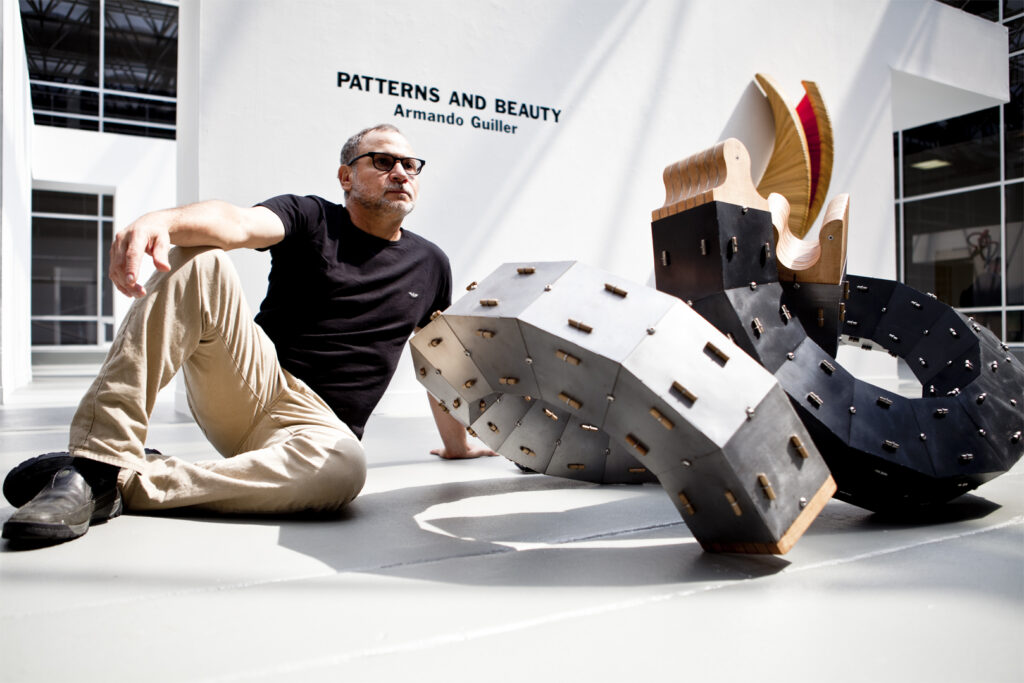
In Guiller’s artwork, the perceptual and conceptual mingle in harmony; they are not irreconcilable opposites but an integral part of the continuous—a core concept in his work. His impeccable modular structures or assemblages, with its parts sometimes numbered, resemble a construction kit, that expand and spiral like a living organism, or a model of the mechanical attributes and mathematical principles of natural philosophy, following Newton’s Natural Principia. There are no ends or starts, but a cyclic movement, frozen in his pieces like the mythical Ouroboros, the snake biting its tail as a symbol of the perpetual cycle of life. He engineers his work from a metaphysical duality, capturing in a single piece a concept and its converse—order/disorder, curves/lines, change/permanence, steady/unsteady. Everything in a dialectical connection, tuned with the principle that every living organism carries on their own decomposition, and every state of the material its dematerialization. “We are surrounded by natural design patterns that in one way or another guide us”.
It’s in this continuum, hunting for the Euclidean geometry, finding the helix as the geometric pattern of the human timeline—as with the logarithmic spiral behind the rhino’s horn embodied the divine and natural geometry for Salvador Dalí—, to the isolation of a sort of visual chromosome, an essential piece containing his basic geometric vision of the universe and its iteration, which allows him to simulate nature and create an infinite universe of shapes through assemblages, that his work becomes more fractal in its repetitive harmony, its self-similarity, and non-integer dimension.
Most of Guiller’s sculptures are an apotheosis of exoskeletal bodies or skinless skeletal forms. They are architectonic in a creative way: defying space, and gravity; and they look even bionic by the robotic appearance of the structured and pseudo articulated bodies. However, with the Euclidean works series, his shapes become more sensual, curvy, turgid, with the flesh breaking out from inside the bones in a kind of late pubescence. These new sensual surfaces proliferate, governed by stylized shapes resembling mid torsos, a quasi-abstract ultramodern chunked black Aphrodite. Every new sculpture is almost an excerpt, a piece of a simplistic universe, sharing the same structure and properties as the whole: “not a drop in the ocean (…) but the entire ocean in a drop,” like the beautiful poem by Rumi.
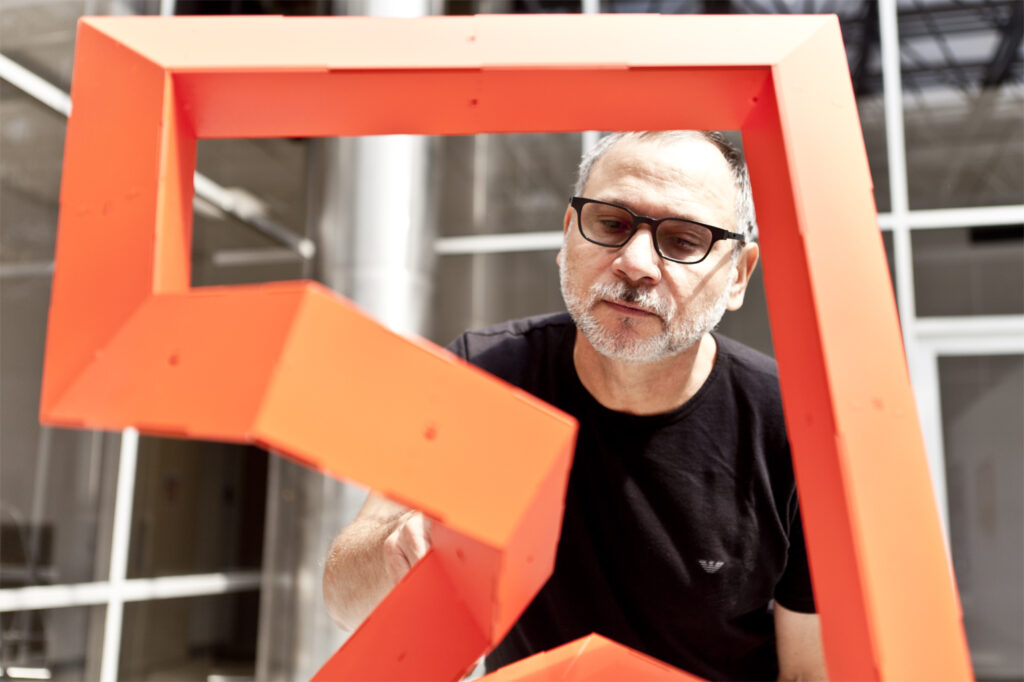
Like a coder translating concepts into shapes, one can suggest that transforming concepts into shapes is the way Amando Guiller understands the world. In his dialectic logic, shapes resume concepts, optimize them in a way more compact and meaningful than words ever can, in what Alejandro Anreus call “beauty that goes beyond rational”.
His sculptures stand against, conceptional artist, Sol LeWitt’s dogmatic assertion that “the physicality of a three-dimensional object (…) is a deterrent to our understanding of the idea and is used as an expressive device”. His works are expressive and conceptual devices at once in such a stronger proportion that looking at them, that it is impossible to think that they are simple structures empty of meaning. We can hardly find any other contemporary sculptor with a more solid conceptual platform and major work so changing from one series to another while staying intrinsically related.
Entropy Structure No. 7
Although most of Guiller’s sculptures can be easily visualized as maquettes for works of monumental scale and even architectural proportions, his first large-scale site-specific sculpture is Entropy Structure No. 7 (2017). The asymmetrical arch in enameled aluminum and stainless steel (11’x10’) is an environmental sculpture located on private property accessible for public view in Stockton, New Jersey.
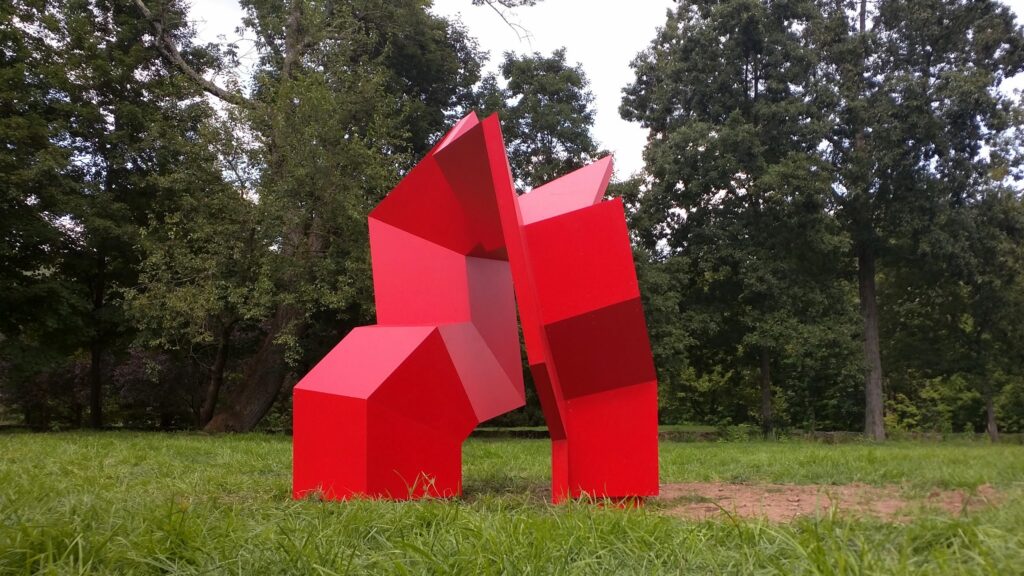
From the studies of orientation, ES7 develops a kinetic nature, changing depending on the position of the viewer. In Guiller’s words, “This piece represents a utopia, because it gradually declines into disorder, returning at some point to order, something scarcely or not seen in nature … The leaf that decomposes does not decompose into the same leaf … So, I intended to make a column transform into an architrave, creating a beautiful passage with the special condition that will return it to a column as soon as you move around it.”
While the sculpture engages and encourages viewers’ interaction, it also integrates itself into the landscape—in a non-intrusive way—, as a flamboyant surreal man-made red bush or giant mushroom which has sprung up in the forest glade. It is also sensual in a sense, like two panels spooning, one embracing the other from the back, welded together in their concavity, becoming a whole in its asymmetrical beauty.

Steel, wall paint
48 x 26 x 16 inches
(Photo courtesy of the artist) DSC
Paraphrasing the great French photographer, Cartier-Bresson, —who comes to mind, because Guiller’s sculptures are in a certain way a snapshot that “fixes a precise movement/moment in time”—, his work is an illusion that demands “putting one’s eye, mind, and heart into alignment.”

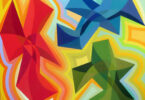


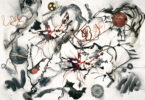
Very interesting exhibition!
[…] En la obra de arte de Guiller, lo perceptivo y lo conceptual se mezclan en armonía; no son opuestos irreconciliables, sino parte integral de lo continuo, un concepto central en su obra. Sus impecables estructuras modulares o ensamblajes, con sus partes a veces numeradas, se asemejan a un kit de construcción, que se expande en espiral como un organismo vivo, o un modelo de los atributos mecánicos y principios matemáticos de la filosofía natural, siguiendo los Principia Naturales de Newton… Para seguir leyendo… […]